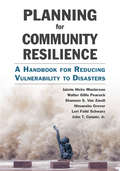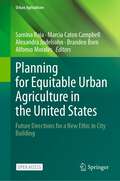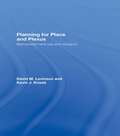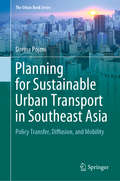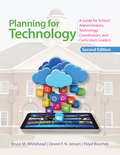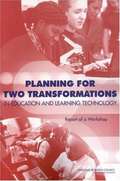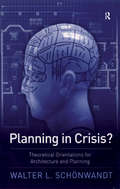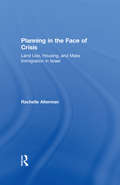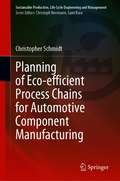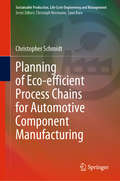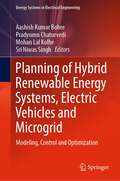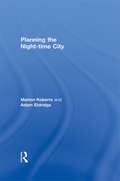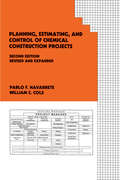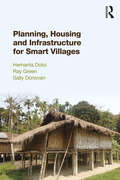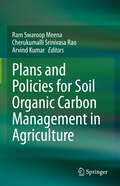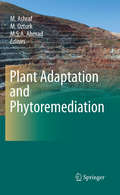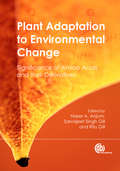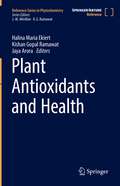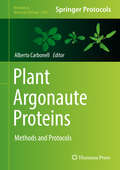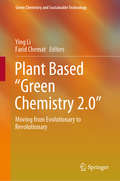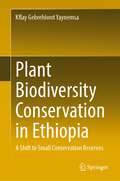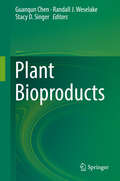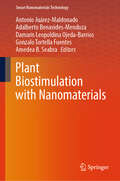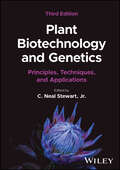- Table View
- List View
Planning for Community Resilience: A Handbook for Reducing Vulnerability to Disasters
by Himanshu Grover John T. Cooper Lori Feild Schwarz Jaimie Hicks Masterson Walter Gillis Peacock Shannon S. ZandtHow can we plan and design stronger communities? From New Orleans to Galveston to the Jersey Shore, communities struck by natural disasters struggle to recover long after the first responders have left. Globally, the average annual number of natural disasters has more than doubled since 1980. These catastrophes are increasing in number as well as in magnitude, causing greater damage as we experience rising sea levels and other effects of climate change. Communities can reduce their vulnerability to disaster by becoming more resilient--to not only bounce back more readily from disasters but to grow stronger, more socially cohesive, and more environmentally responsible. To be truly resilient, disaster preparation and response must consider all populations in the community. By bringing together natural hazards planning and community planning to consider vulnerabilities, more resilient and equitable communities are achievable. In Planning for Community Resilience the authors describe an inclusive process for creating disaster-resilient communities. Based on their recovery work after Hurricane Ike in Galveston, Texas, they developed a process that relies on the Disaster Impacts Model. This handbook guides any community through the process of determining their level of hazard exposure, physical vulnerability, and social vulnerability with the goal of determining the best planning strategy. Planning for Community Resilience will be invaluable to professionals working to protect their community from disturbance, including city planners, elected officials, floodplain managers, natural hazard managers, planning commissioners, local business leaders, and citizen organizers.
Planning for Equitable Urban Agriculture in the United States: Future Directions for a New Ethic in City Building (Urban Agriculture)
by Alfonso Morales Samina Raja Marcia Caton Campbell Alexandra Judelsohn Branden BornThis open access book, building on the legacy of food systems scholar and advocate, Jerome Kaufman, examines the potential and pitfalls of planning for urban agriculture (UA) in the United States, especially in how questions of ethics and equity are addressed. The book is organized into six sections. Written by a team of scholars and practitioners, the book covers a comprehensive array of topics ranging from theory to practice of planning for equitable urban agriculture. Section 1 makes the case for re-imagining agriculture as central to urban landscapes, and unpacks why, how, and when planning should support UA, and more broadly food systems. Section 2, written by early career and seasoned scholars, provides a theoretical foundation for the book. Section 3, written by teams of scholars and community partners, examines how civic agriculture is unfolding across urban landscapes, led largely by community organizations. Section 4, written by planning practitionersand scholars, documents local government planning tied to urban agriculture, focusing especially on how they address questions of equity. Section 5 explores UA as a locus of pedagogy of equity. Section 6 places the UA movement in the US within a global context, and concludes with ideas and challenges for the future. The book concludes with a call for planning as public nurturance – an approach that can be illustrated through urban agriculture. Planning as public nurturance is a value-explicit process that centers an ethics of care, especially protecting the interests of publics that are marginalized. It builds the capacity of marginalized groups to authentically co-design and participate in planning/policy processes. Such a planning approach requires that progress toward equitable outcomes is consistently evaluated through accountability measures. And, finally, such an approach requires attention to structural and institutional inequities. Addressing these four elements is more likelyto create a condition under which urban agriculture may be used as a lever in the planning and development of more just and equitable cities. This is an open access book.This is an open access book.
Planning for Place and Plexus: Metropolitan Land Use and Transport
by David M. Levinson Kevin J. KrizekPlanning for Place and Plexus provides a fresh and unique perspective on metropolitan land use and transport networks, challenging current planning strategies and offering frameworks to understand and evaluate policy. The book suggests actions for the future urban growth of metropolitan areas and includes current and cutting edge theory, findings, and recommendations which are cleverly illustrated throughout using international examples.
Planning for Sustainable Urban Transport in Southeast Asia: Policy Transfer, Diffusion, and Mobility (The Urban Book Series)
by Dorina PojaniBy now, planners everywhere know - more or less - what the ingredients of a sustainable city are, in theory. The problem is that only bits of solutions are being implemented in the cities that most need them, the majority of which are located in the Global South. This book examines issues related to policy transfer in urban transport planning in Southeast Asia. The metropolitan regions of four major capitals - Jakarta, Kuala Lumpur, Manila, and Bangkok - are considered. The book assesses the in-bound and out-bound transfer of sustainable transport planning policies, concepts, and tools. The investigation focuses on who transfers policy and why, what elements of policy are transferred, in what direction and to what degree, and what barriers does transfer face. It also discusses how policy transfer processes in the transportation planning arena can be improved.
Planning for Technology: A Guide for School Administrators, Technology Coordinators, and Curriculum Leaders
by Bruce M. Whitehead Dr Floyd A. Boschee Devon JensenStay a step ahead of technological change so that every student can flourish! Students and classrooms are growing more technologically savvy every semester, and falling behind is not an option. This new edition of an essential text shows educational leaders how to equip their students for the future, with updates such as: Digital developments of the past decade that school leaders must address New content covering the Common Core, distributed leadership, adult learning theory, digital citizenship, cybersecurity, cloud computing, and more A new chapter on creating a “culture of technology” that goes beyond mere user manuals to create responsible, tech-savvy students
Planning for Two Transformations in Education and Learning Technology: Report of a Workshop
by Information Technology Committee on Improving LearningIn response to concerns about the continued unrealized potential of IT in K-12 education, the National Research Council’s Division of Behavioral and Social Sciences and Education, Center for Education (CFE), Board on Behavioral, Cognitive, and Sensory Sciences (BBCSS), and Computer Science and Telecommunications Board (CSTB) undertook a collaborative project to help the IT, education research, and practitioner communities work together to find ways of improving the use of IT in K-12 education for the benefit of all students.
Planning in Crisis?: Theoretical Orientations for Architecture and Planning
by Walter SchoenwandtIn recent years, a formidable gulf has opened up between planning theory and practice. Over the past four decades, planning academics have developed strong theories and created models to accompany and elucidate the planning process. However, many planning practitioners have resisted the notion that theory can play a positive role in the solution of concrete planning problems This volume provides a comprehensive overview of all the main planning theories and models, while also introducing an innovative new model and a set of tools. Modeled on the theories of Mario Bunge this dynamic new approach allows planners to achieve a better understanding of the complexities involved in the role of planners and their impact on the built environment.
Planning in the Face of Crisis: Land Use, Housing, and Mass Immigration in Israel (Cities And Regions Ser.)
by Rachelle AltermanCritics of urban and regional planning argue that it is best suited to manage incremental change. Can a planner's skills and expertise be effective in handling a major crisis and large-scale change? The mass immigration from the former Soviet Union to Israel in the 1990s offers the opportunity to study one of the largest-scale (non-disaster) crisis situations in a democratic, advanced-economy country. This book recounts the fascinating saga of how policymakers and planners at both the national and local levels responded to the formidable demand for housing and massive urban growth. Planners forged new housing and land-use policies, and applied a streamlined (but controversial) planning law. The outputs were impressive. The outcomes and impacts changed the landscape and human-scape of Israel, heightening dilemmas of land use and urban policy in this high-density country.
Planning of Eco-efficient Process Chains for Automotive Component Manufacturing (Sustainable Production, Life Cycle Engineering and Management)
by Christopher SchmidtThis book includes the introduction of emerging manufacturing technologies and planning cases with established technologies. The planning of eco-efficient process chains is crucial for manufacturing companies. However, in the state-of-the-art planning, various barriers exist towards the integration of the environmental dimension.Against this background, a concept for the integration of classic lean and environmental criteria into the three planning phases of process chains is presented. During concept planning, the Technology Assessment Tool supports planners in the identification of eco-efficient technologies. During rough planning, the Value Stream Design Tool enables the derivation of a production line based on workpiece characteristics. For detailed planning, tools for eco-efficient machine and process chain configuration are provided. Three case studies from large-scale automotive component manufacturing with established and emerging technologies demonstrate the tool applicability.
Planning of Eco-efficient Process Chains for Automotive Component Manufacturing (Sustainable Production, Life Cycle Engineering and Management)
by Christopher SchmidtThis book includes the introduction of emerging manufacturing technologies and planning cases with established technologies. The planning of eco-efficient process chains is crucial for manufacturing companies. However, in the state-of-the-art planning, various barriers exist towards the integration of the environmental dimension.Against this background, a concept for the integration of classic lean and environmental criteria into the three planning phases of process chains is presented. During concept planning, the Technology Assessment Tool supports planners in the identification of eco-efficient technologies. During rough planning, the Value Stream Design Tool enables the derivation of a production line based on workpiece characteristics. For detailed planning, tools for eco-efficient machine and process chain configuration are provided. Three case studies from large-scale automotive component manufacturing with established and emerging technologies demonstrate the tool applicability.
Planning of Hybrid Renewable Energy Systems, Electric Vehicles and Microgrid: Modeling, Control and Optimization (Energy Systems in Electrical Engineering)
by Sri Niwas Singh Mohan Lal Kolhe Pradyumn Chaturvedi Aashish Kumar BohreThis book focuses on various challenges, solutions, and emerging technologies in the operation, control, design, optimization, and protection of microgrids in the presence of hybrid renewable energy sources and electric vehicles. This book provides an insight into the potential applications and recent development of different types of renewable energy systems including AC/DC microgrids, RES integration issues with the grid, electric vehicle technology, etc. The book serves as an interdisciplinary platform for the audience working in the focused area to access information related to energy management, modeling, and control. It covers fundamental knowledge, design, mathematical modeling, applications, and practical issues with sufficient design problems and case studies with detailed planning aspects. This book will serve as a guide for researchers, academicians, practicing engineers, professionals, and scientists, as well as for graduate and postgraduate students working in the area of various applications of RES, Electric Vehicles, and AC/DC Microgrid.
Planning the Night-time City
by Marion Roberts Adam EldridgeThe night-time economy represents a particular challenge for planners and town centre managers. In the context of liberalised licensing and a growing culture around the '24-hour city', the desire to foster economic growth and to achieve urban regeneration has been set on a collision course with the need to maintain social order. Roberts and Eldridge draw on extensive case study research, undertaken in the UK and internationally, to explain how changing approaches to evening and night-time activities have been conceptualised in planning practice. The first to synthesise recent debates on law, health, planning and policy, this research considers how these dialogues impact upon the design, management, development and the experience of the night-time city. This is incisive and highly topical reading for postgraduates, academics and reflective practitioners in Planning, Urban Design and Urban Regeneration.
Planning, Estimating, and Control of Chemical Construction Projects (Cost Engineering)
by Pablo F. Navarrete William C. ColeContains added chapters emphasizing the importance of choosing the correct project and defining project goals. Stresses the need for adequate front end loading (FEL) and outlines the responsibility of the venture manager in project selection. Provides updated case studies and examples on technical evaluation criteria, construction progress monitori
Planning, Housing and Infrastructure for Smart Villages
by Sally Donovan Ray Green Hemanta DoloiSome 7.3 billion people currently live on the planet. Of these, 3.4 billion live in rural areas. In just a few regions—Latin America, the Middle East and North Africa—less than 50 per cent of poverty is now located in rural areas. But for the rest of the world's regions between 55 per cent and 80 per cent of the poor continue to live in the countryside. Progress is being made, but much of the knowhow needed is not disseminated outside of a small coterie of professionals who work in the area. With urban development attracting a great deal of attention lately, poorer rural areas deserve the same and new knowledge for empowerment of rural communities is urgently needed. This book provides an overview of current thinking and practices that have emerged over the last thirty years for uplifting rural communities in developing economies. Drawing on a body of knowledge across a spectrum of relevant disciplines, this book provides a range of innovative ideas for rural planning, housing and infrastructure development. Governments in many emerging economies, where rural poverty is often most acute, have attempted to improve livelihoods. Approaches and techniques that have been used for urban development are often not applicable to rural communities. Studies show that money allocated for rural development is often not effectively spent due to distance, lack of infrastructure, lack of education, poverty and other factors. Meanwhile, the gap in development between the city and country continues to grow, sometimes leading to social and political instability, in both developing and developed countries. This book seeks to provide a guidebook for meeting such challenges. Through in-depth enquiry of global practices and thinking about rural development, and selected case studies, the authors argue that careful consideration must be given to incorporating issues of resilience, resourcefulness and the involvement of communities at grassroots levels in realising the transformation of rural settlements into Smart Villages.
Plans and Policies for Soil Organic Carbon Management in Agriculture
by Arvind Kumar Ram Swaroop Meena Cherukumalli Srinivasa RaoThis edited book discusses how effective soil carbon management plans and policies will ultimately make agriculture more secure against climate change and soil degradation. It is focused on initiatives to enhance soil organic carbon (SOC) and sequestration by launching different schemes and programs. An approach based on practical aspects of managing SOC in agriculture is provided with clear and concise descriptions. It has more attention to successfully implement plans and policies to meet the required level of SOC restoration. The book is covering the urgent needs of plans and policies for soil management and C restoration in agricultural ecosystems which can be beneficial to food, nutrition, environment, and economy security. There is also providing a roadmap on SOC policies to encourage the use of best management practices (BMPs) for soil health and C stock restoration, and achieve the Sustainable Development Goals of the United Nations. The book is suitable for teachers, researchers, government planners and policymakers, undergraduate and graduate students of soil science, soil microbiology, agronomy, ecology, and environmental sciences.
Plant Adaptation and Phytoremediation
by M. Ashraf M. S. Ahmad M. OzturkThe problems engendered by the conflicting imperatives of development and ecology show no sign of ending, and every day more locations are added to the list of landscapes poisoned by human activity. This vital book, featuring an international set of authors, is a key reference for researchers and environmental managers, as well as anyone involved in the mining industry or landscape remediation. The comprehensive coverage of current approaches to phytoremediation begins by examining the problem. It looks at natural and human-induced toxins, and their effects on natural vegetation as well as agricultural crops. Particular attention is paid to the two largest challenges to remediation - heavy metals, and the salt stress that is impeding agricultural productivity worldwide. The text moves on to focus on the efficacy of different plant species in removing toxic pollutants from the environment. Along with analysis of a number of case studies, this section includes new and updated information on the mechanism of toxin-tolerance in plants.
Plant Adaptation to Environmental Change
by Sarvajeet Singh Gill Firdaus Bareen Masayuki Fujita A Aziz Antonio Márquez Antonio Tiburcio Oscar Ruiz Vera Alexieva Bhaskar Gupta B. Vidya Vardhini Renu Bhardwaj Ritu Gill Penna Suprasanna Yoshikatsu Murooka Naser A Anjum Jose Luis MartinezPlants constantly cope with unfavourable ecosystem conditions, which often prevent them reaching their full genetic potential in terms of growth, development and productivity. This book covers plants' responses to these environmental changes, namely, the modulation of amino acids, peptides and amines to combat both biotic and abiotic stress factors. Bringing together the most recent developments, this book is an important resource for researchers and students of crop stress and plant physiology.
Plant Adaptation to Environmental Change: Significance of Amino Acids and their Derivatives
by Firdaus Bareen Masayuki Fujita A Aziz Antonio Márquez Antonio Tiburcio Oscar Ruiz Vera Alexieva Bhaskar Gupta B. Vidya Vardhini Renu Bhardwaj Penna Suprasanna Yoshikatsu Murooka Jose Luis MartinezPlants constantly cope with unfavourable ecosystem conditions, which often prevent them reaching their full genetic potential in terms of growth, development and productivity. This book covers plants' responses to these environmental changes, namely, the modulation of amino acids, peptides and amines to combat both biotic and abiotic stress factors. Bringing together the most recent developments, this book is an important resource for researchers and students of crop stress and plant physiology.
Plant Antioxidants and Health (Reference Series in Phytochemistry)
by Kishan Gopal Ramawat Halina Maria Ekiert Jaya AroraThis book provides a comprehensive reference guide to plant-derived antioxidants, their beneficial effects, mechanisms of action, and role in disease prevention and improving general health (anti-ageing effect). The content is divided into three main parts, the first of which covers various antioxidants (such as polyphenols, carotenoids, tocopherols, tocotrienols, glutathione, ascorbic acid), their origins, plant biochemistry and industrial utilization. In turn, the book’s second, main part focuses on antioxidants’ beneficial health effects, explains biochemical fundamentals such as the free radical theory and oxidative stress, and discusses antioxidants’ role in e.g. cancer, cardiovascular diseases, inflammation, degenerative diseases and ageing. The third part reviews general laboratory methods for antioxidant screening, preservation and determination. Written by an international team of experts, this highly interdisciplinary book will benefit a broad range of health professionals and researchers working in biochemistry, biotechnology, nutrition, plant science and food chemistry. It offers an indispensable, up-to-date guide for anyone interested in antioxidants and the role of a plant-based diet in disease prevention and control
Plant Argonaute Proteins
by Alberto CarbonellThis volume provides the reader with step-by-step methods to study plant ARGONAUTE (AGO) functions. Chapters in Plant Argonaute Poteins: Methods and Protocols summarize the main biochemical, molecular and cytological methods to study AGO-small RNA complexes and their interactions with target RNAs, AGO subcellular localization, AGO association with polysomes, AGO role in meiosis and DNA repair, methods for the identification, cloning and characterization of AGO genes in different plant species, and non-radioactive protocols for small RNA detection. Finally, a series of chapters describing computational methods to study plant AGO function and evolution are provided. Written in the highly successful Methods in Molecular Biology series format, chapters include introductions to their respective topics, lists of the necessary materials and reagents, step-by-step, readily reproducible laboratory protocols, and tips on troubleshooting and avoiding known pitfalls. Authoritative and practical, Plant Argonaute Proteins: Methods and Protocols aims to deliver the most complete and updated list of protocols to study plant AGO function.
Plant Based “Green Chemistry 2.0”: Moving from Evolutionary to Revolutionary (Green Chemistry and Sustainable Technology)
by Farid Chemat Ying LiThis book provides practical information on obtaining and using a wide variety of plant based reagents for different sectors, addressing the needs and challenges in a single resource. The chapters complement each other seamlessly and present contributions from reputed international researchers and renowned professionals from industry, covering the latest efforts in the field. The book serves as the starting point for future collaborations in the new area “Plant Based Green Chemistry” between research, industry, and education, covering large ecologic and economic applications: perfume, cosmetic, pharmaceutical, food ingredients, nutraceuticals, biofuels, or fine chemicals industries. This book is aimed at professionals from industries, academicians engaged in plant based green chemistry, researchers and graduate level students, but will also be useful to food technologists and students and researchers involved in natural products chemistry.
Plant Biodiversity Conservation in Ethiopia: A Shift to Small Conservation Reserves
by Kflay Gebrehiwot YaynemsaThis book covers biodiversity conservation under special consideration of the challenges in the global south with particular attention being paid to consider the existing conservation challenges in relation to the study area in Ethiopia. Key issues are addressed, such as the current and future threats to plant biodiversity in Ethiopia, as well as the single large or several small conservation approaches and which approach is feasible for Ethiopia. Furthermore, an innovative approach was developed that enhances ecological connectivity and promotes ecological restoration through community involvement. The book also covers why a systematic conservation planning approach is important and should be used in new protected area establishments, and also looks at the trends of plant ecology research over the past five decades, revealing research gaps and suggesting future research topics. Despite its focus on Ethiopian plant diversity, abundant examples were used from different continents making this book attractive to global readers. It will be of interest for policy- and decision-makers in the conservation sector, researchers interested in biodiversity, climate change, conservation and sustainable use of natural resources, and would be a valuable resource for university students.
Plant Bioproducts
by Guanqun Chen Randall J. Weselake Stacy D. SingerAmong the major challenges facing society today, seeking renewable alternatives to petroleum-based fuels and manufactured goods is critically important to reducing society’s dependency on petroleum and tackling environmental issues associated with petroleum use. In recent years there has been considerable research targeted toward the development of plant-derived bioproducts to replace petrochemical feedstocks for both fuel and manufacturing. Plants not only provide a large amount of renewable biomass, but their biochemical diversity also offers many chemical and molecular tools for the production of new products through biotechnology. Plant Bioproducts is an introduction to the production and application of plant bioproducts, including biofuels, bioplastics, and biochemicals for the manufacturing sector. Contributing authors examine various bioproducts with respect to their basic chemistry, relationship to current petrochemical-based products, and strategies for their production in plants. Chapters cover the integrated roles of agronomy, plant breeding, biotechnology, and biorefining in the context of bioproduct development. Environmental, economic, ethical, and social issues surrounding bioproducts, including the use of genetically modified crops, challenges to food security, and consumer acceptance, are also covered.
Plant Biostimulation with Nanomaterials (Smart Nanomaterials Technology)
by Amedea B. Seabra Antonio Juárez-Maldonado Adalberto Benavides-Mendoza Damaris Leopoldina Ojeda-Barrios Gonzalo Tortella FuentesThis book covers the topic of biostimulation of crops using nanomaterials to increase crop production and quality improvement, accompanied by the reduction of environmental impact in the form of less use of pesticides and greater efficiency in the use of fertilizers and water. Different classes of biostimulants have been recognized and studied, but nanomaterials are among the most recently considered with a dual category of biostimulation-inducing physical and chemical agents. The physical process of biostimulation occurs through interactions at the interfaces of the nanomaterial corona and cell walls and membranes. In contrast, the chemical process depends on the corona and core composition. The chapters in this book present the different topics of biostimulation with nanomaterials with the consideration of different spheres of organization, from the molecular view to agricultural ecosystems. It looks at the interactions between nanomaterials and plant cells that differ depending on the corona's size, shape, specific surface, and composition, in addition to the dynamic biological contexts of development and interaction with other environmental factors. The book caters to researchers and scientists who are interested in the biostimulation of crops using nanomaterials and their long-term ecological impact.
Plant Biotechnology and Genetics: Principles, Techniques, and Applications
by C. Neal StewartDiscover the latest edition of this authoritative textbook on plant biotechnology and genetics Plant biotechnology is a field of research and development in which scientific techniques are brought to bear on the creation and modification of new, beneficial plants and strains. Biotechnological techniques can be used to add nutritive value, increase resistance to diseases and pests, increase yields, and more. The production of biotech crops has increased over one hundred times since their introduction into commercial agriculture in 1996, making them the most rapidly-adopted crop category in the history of modern agriculture. Plant Biotechnology and Genetics is the essential introduction to this thriving research subject. Beginning with an overview of basic plant biology and genetics, it then moves to the fundamental elements of biotechnology. Now fully updated to reflect the latest research advances and technological breakthroughs, it continues to be a must-own for readers interested in the future of food production and more. Readers of the third edition of Plant Biotechnology and Genetics will also find: New chapters covering topics like genome editing, chloroplast genome engineering, and synthetic biologyUpdates throughout to incorporate increased coverage of haploid production, genomic selection, and moreSummary and discussion questions in each chapter, along with a companion website incorporating images and lecture materials Plant Biotechnology and Genetics is ideal for advanced undergraduate and masters students in plant biotechnology courses, as well as professionals seeking a helpful reference guide.
